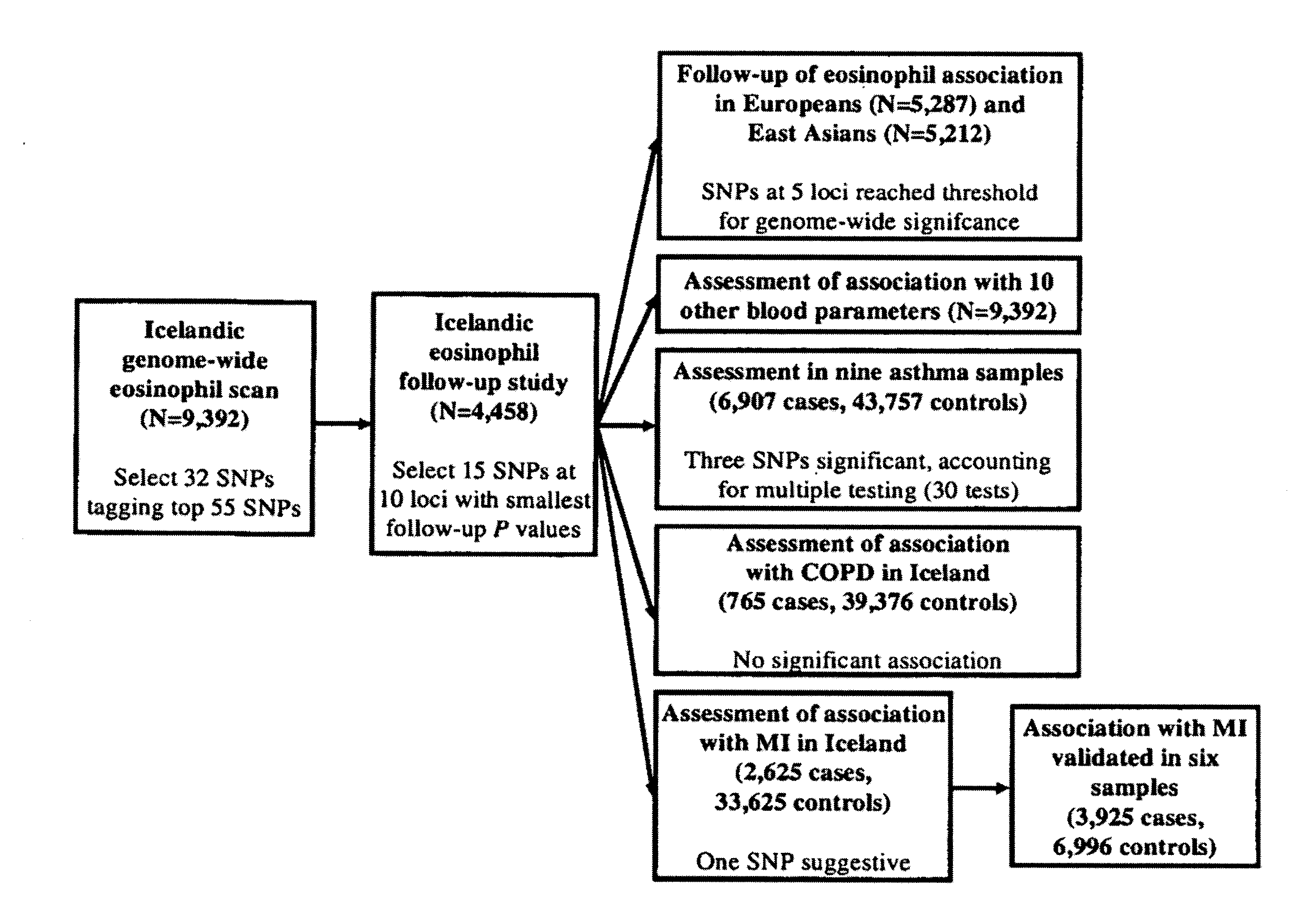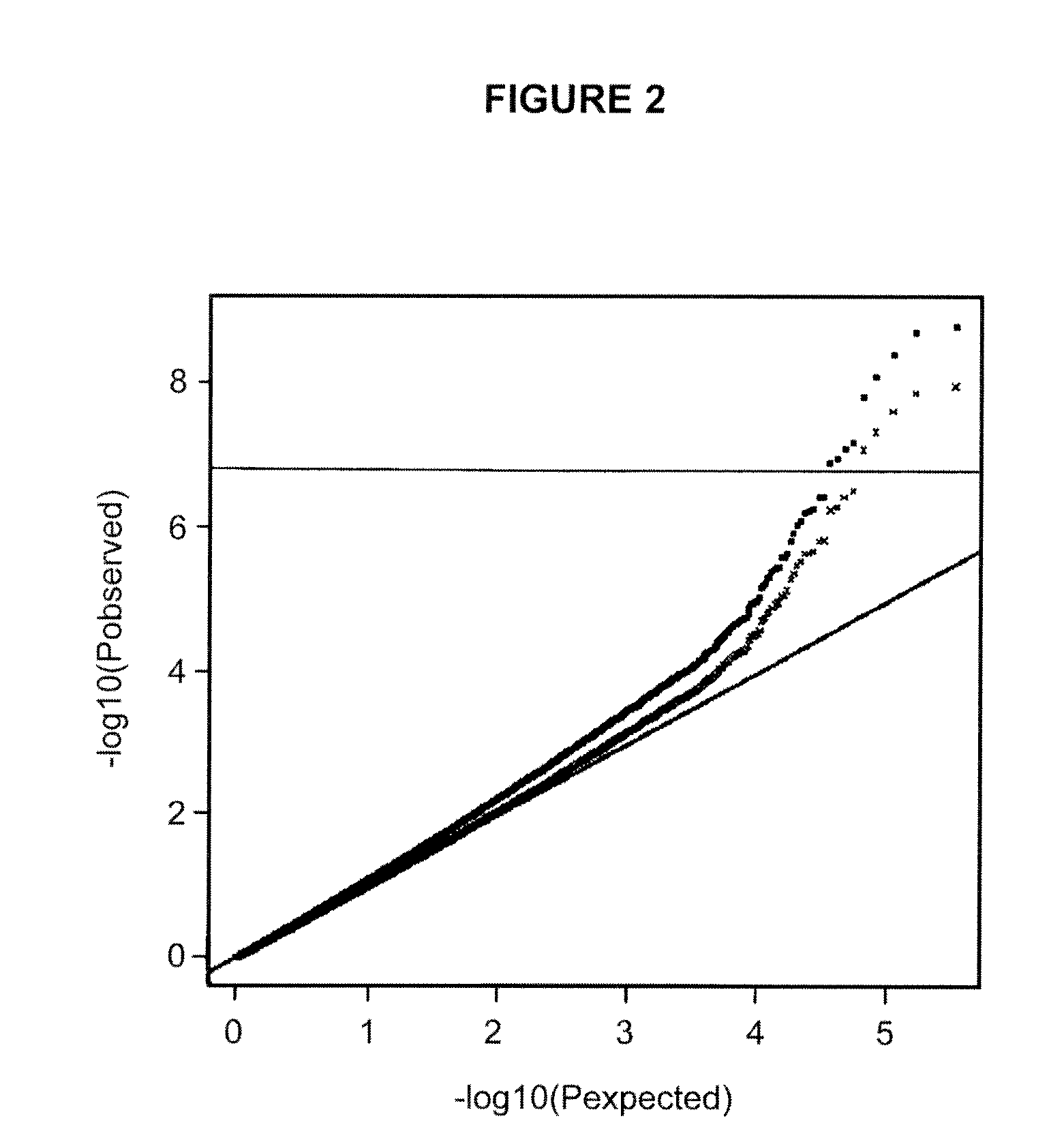Genetic Variants as Markers for Use in Diagnosis, Prognosis and Treatment of Eosinophilia, Asthma, and Myocardial Infarction
a technology of eosinophilia and gene variants, which is applied in the direction of instruments, catheters, angiography, etc., can solve the problems of nerve damage, heart failure, lung disease, and blood clots, and achieve the effects of reducing the risk of eosinophilia, and improving the prognosis and treatmen
- Summary
- Abstract
- Description
- Claims
- Application Information
AI Technical Summary
Benefits of technology
Problems solved by technology
Method used
Image
Examples
example 1
[0315]Circulating eosinophils were counted in 110,211 blood samples from 39,142 Icelanders seeking medical care at an Iceland Medical Center (Laeknasetrid), a clinic specializing in internal medicine, between the years 1997 and 2008. The measurements were performed in the Laboratory in Mjodd, RAM, Reykjavik, Iceland. Data from 469 blood samples were removed from the analysis because the sum of differential white blood cell counts were more than 2% from the directly counted number of white blood cells, leaving 109,742 measurements from 39,055 Icelanders. The circulating eosinophil numbers were standardized to a standard normal distribution using quantile-quantile standardization and then adjusted for sex, year of birth, and age at measurement.
[0316]In order to get an estimate for the quality of the adjusted circulating eosinophil numbers, we broke its variance (V) into two components, a between individual component (I) and a within individual, or residual, component (R), such that V=...
example 2
[0324]This example demonstrates whether the eosinophil loci were specific to eosinophils or had effect on more blood parameters.
[0325]Data on white blood cell differential counts, platelet counts, and several red blood cell parameters were analyzed for the set of Icelanders having blood eosinophil counts. IgE measurements were also available for a smaller subset of individuals. FIG. 5 shows an overview of the association of the SNPs identified through the blood eosinophil count genome-wide scan with all these blood measurements. The results of the analysis is shown in Table 9.
TABLE 9EosinophilsNeutrophilsLymphocytesMonocytesBasophilesWBCSNPEff.aPEff.aPEff.aPEff.aPEff.aPEffaPrs14201019.06.4 × 10−141.20.27−0.20.830.70.530.20.881.80.13rs126192856.58.5 × 10−70.30.810.20.90−0.20.890.01.00.20.85rs48578559.97.3 × 10−11−3.40.0162.30.111.20.4114.51.8 ×−1.30.3810−25rs414383212.31.9 × 10−140.40.791.70.24−0.10.952.20.132.20.15rs22694266.43.5 × 10−73.34.4 × 10−32.91.2 × 10−23.33.8 × 10−33.87.3 ×...
example 3
[0327]Given the role of eosinophils in the pathogenesis of asthma, the fifteen SNPs from the ten loci identified through the blood eosinophil count scan were tested for association with asthma and with its sub-phenotypes of atopic and non-atopic asthma in seven case control sample sets of European origin and one sample set of East Asian origin. Even though the association of SNPs at only six of the ten loci reached our threshold for genome-wide significance for association with eosinophil counts, the association of all fifteen SNPs with asthma was assessed, since some of the five remaining suggestive loci may yet be true positives.
[0328]The association of SNPs identified in the eosinophil genome-wide scan with asthma in seven sample sets (European and one East Asian sample set) are shown below in Tables 10 and 11.
TABLE 10AsthmaAtopic AsthmaControlFreqORFreqSampleFreq (N)(N)(95% CI)P(N)rs1420101 A - in the IL1RL1 geneIceland40.6(38, 349)43.9(2, 227)1.158.7 · 10−542.8(881)(1.07, 1.23)...
PUM
| Property | Measurement | Unit |
|---|---|---|
| Tm | aaaaa | aaaaa |
| Tm | aaaaa | aaaaa |
| Tm | aaaaa | aaaaa |
Abstract
Description
Claims
Application Information
 Login to view more
Login to view more - R&D Engineer
- R&D Manager
- IP Professional
- Industry Leading Data Capabilities
- Powerful AI technology
- Patent DNA Extraction
Browse by: Latest US Patents, China's latest patents, Technical Efficacy Thesaurus, Application Domain, Technology Topic.
© 2024 PatSnap. All rights reserved.Legal|Privacy policy|Modern Slavery Act Transparency Statement|Sitemap



